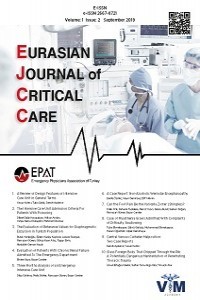POST ERCP PERFORATION: A CASE REPORT
POST ERCP PERFORATION: A CASE REPORT
Abdominal pain, perforation, ERCP,
___
- 1. Freeman ML, Nelson DB, Sherman S, et al. Complications of endoscopic biliary sphincterotomy. N Engl J Med, 1996; 335: 909-918.
- 2. Enns R, Eloubeidi MA, Mergener K, et al. ERCP-relatedperforations: risk factors and management Endoscopy 2002; 34:293.
- 3. Chung RS, Sivak MV, Ferguson DR. Surgical decisions in the management of duodenal per¬foration complicating endoscopic sphincter¬otomy. Am J Surg, 1993; 165: 700-703.
- 4. Stapfer M, Selby RR, Stain SC, et al. Management of duodenal perforation after endoscopic retrograde cholangiopancreatography and sphincterotomy. AnnSurg 2000; 232:191.
- 5. Wu HM, Dixon E, May GR, Sutherland FR. Management of perforation after endoscopic retrograde cholangiopancreatography (ERCP): a population-based review. HPB (Oxford) 2006; 8:393.
- 6. Fatima J, Baron TH, Topazian MD, et al. Pancreaticobiliary and duodenal perforations after periampullary endoscopic procedures: diagnosis and management. ArchSurg 2007; 142:448.
- 7. Morgan KA, Fontenot BB, Ruddy JM, et al. Endoscopic retrograde cholangiopancreatography gut perforations: when to wait! When to operate! AmSurg 2009; 75:477.
- 8. Assalia A, Suissa A, Ilivitzki A, et al. Validity of clinical criteria in the management of endoscopic retrograde cholangiopancreatography related duodenal perforations. ArchSurg 2007; 142:1059.
- 9. Howard TJ, Tan T, Lehman GA, et al. Classification and management of perforations complicating endoscopic sphincterotomy. Surgery 1999; 126:658.
- 10. Chaudhary A, Aranya RC. Surgery in perforation after endoscopic sphincterotomy: sooner, later or not at all? Ann R Coll Surg Engl 1996; 78:206.
- 11. Chung RS, Sivak MV, Ferguson DR. Surgical decisions in the management of duodenal perforation complicating endoscopic sphincterotomy. Am J Surg 1993; 165:700.
- Başlangıç: 2019
- Yayıncı: Acil Tıp Uzmanları Derneği
POST ERCP PERFORATION: A CASE REPORT
Hasan GÖKÇE, Muhammed EKMEKYAPAR, Şükrü GÜRBÜZ, Serdar DERYA
Periorbital Air Following Sneeze: Case Report
Yağmur Gökhan SEMERCİ, Cesareddin DİKMETAŞ, Ayla KÖKSAL, Dilek ATİK, Serkan DOĞAN, Duygu YAMAN, Başar CANDER
Ramazan ÜNAL, Dilek ATİK, Ahmet ERDUR, Bensu BULUT, Hasan ÇAM, Salih FETTAHOĞLU, Ramazan GÜVEN, Başar CANDER
A RARE TRAUMA COMPLICATION: PNEUMOPERICARDIUM
Ömür UYANIK, Muhammed EKMEKYAPAR, Hakan OĞUZTÜRK, Şükrü GÜRBÜZ, Ramazan AVCU
Does a potato threat your life? A Case Study
Serkan DOĞAN, Bensu BULUT, Ramiz YAZICI, Canan AKMAN, Zeynep SARAL ÖZTÜRK, Ekim SAĞLAM GÜRMEN, Tarık OCAK, Başar CANDER
Dilek ATİK, Bengu SELİMAN, Derya BALCI KOROGLU, Bensu BULUT, Bahadır TASLIDERE
Bilateral Facial Paralysis Following Tooth Extraction: Case Report
Dilek ATİK, Cesareddin DİKMETAŞ, Ayla KÖKSAL, Serkan DOĞAN, Ahmet ERDUR, Basar CANDER
THE NEW BIOMARKERS USED IN THE DIFFERENTIATION BETWEEN TRANSUDATE AND EXUDATE PLEURAL EFFUSIONS
Exposure to Infrared Light: Case Series
Ayla KÖKSAL, Cesareddin DİKMETAŞ, Büşra BİLDİK, Serkan DOĞAN, Dilek ATİK, Başar CANDER
